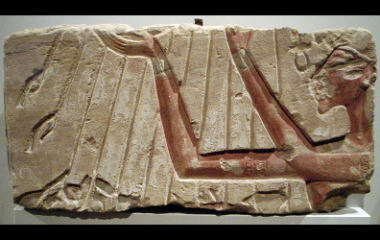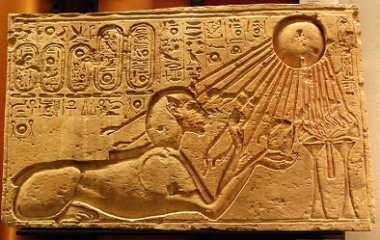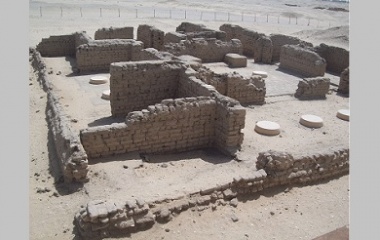Akhenaten introduced many changes into Egyptian society at the time of his rule, most notably, the worship of one god: Aten. The people took an inimical view of his radical agenda, however, resulting in him being labelled the Heretic and his name being removed from the list of Egyptian Pharaohs!
What Is Aten?
In ancient Egyptian mythology, Aten, also spelled Aton, is the sun disk and was worshipped from as early as the 3rd dynasty as an aspect of Ra. The worship of a deified form of Aten became a state religion during the rule of Amenhotep IV, who later changed his name to Akhenaten (meaning effective for Aten).
Source
Aten is first mentioned as a deity in the 12th dynasty literary work, The Story of Sinuhe, and is also mentioned in the ancient Egyptian Book of the Dead. The Aten Hymn, attributed to Akhenaten, bears further reference to the deity in the form of a poetic veneration found inscribed in various versions on the tombs of courtiers.
Appearance
The symbol of Aten appeared as a sun disk with the sun’s rays emanating from the disk and terminating in human hands, together with the ankh. Unlike other gods and goddesses, Aten was never represented in a human form and his name appeared on cartouches along with the titles usually ascribed to a Pharaoh.
The Rise of Aten
During the reign of Akhenaten from 1353 to 1336 BC, Egypt saw great religious and cultural changes, many of which were not well received by the people. The worship of many gods and goddesses had been an intrinsic part of Egyptian religion for thousands of years, yet, even with this long history of polytheism, Akhenaten turned the tables and forced monotheism on the people.
In the beginning of his reign, he and his wife, Nefertiti, worshiped the many gods and goddesses – in particular, Amun. At this time, the capital was located in Thebes, which also housed the great temple of Amun. The priests of Amun gained much wealth and power during this period, possibly even more than the Pharaoh himself. Perhaps after his observation of the sun and its life-giving powers, Akhenaten interpreted Aten, still a lesser-known sun disk deity, as being omnipresent and the principle life-giving force of the universe. He came to believe Aten was the only god and began to worship only him.
Akhetaten
In order to establish themselves and their new religion with greater eminence, Akhenaten and Nefertiti moved from the opulent Thebes and its grand temple of Amun to a new capital, Akhetaten. Though the people were not keen to give up polytheism in favor of just one god, the worship of the sun disk now replaced the worship of Amun and other deities.
New temples were built to venerate Aten, and Amenhotep IV, as he was known at the time, changed his name to Akhenaten. He then began to associate himself very closely with the image of Aten, portraying himself as both the mother and father of Egypt. He viewed himself as a living god and the only representative of Aten on Earth, aside from his wife, thereby imbuing her with more power than the priests! Under his religious rule, bordering on tyranny, it was further declared that the rays of light from the sun-disk shone on the royal family alone. Everybody else could only receive life through him and Nefertiti, if they were loyal to Aten.
The Pharaoh’s obsession with building the cult of Aten left Egypt militarily weak to the point where land was taken over by the Hittites. This did little to garner the support of his people, who were already aggrieved by all the power and wealth of Egypt being directed to this singular deity.
Aten Temples and Priests
The Aten temples were open-roofed and colorful, in contrast to earlier temples, allowing light to flood into the building. The temples housed no statues of the deity as this was considered idolatry, but they did have representations of the Pharaoh and his family worshiping Aten! The priests were expected to worship Akhenaten and Nefertiti as gods on earth and, though there were no processions in Aten’s name, the people had their chance to pay homage to the royal family when they rode in their chariot on festival days. Not only were the temples of other gods destroyed in the name of Aten, but the Pharaoh even erased his own father’s cartouche where it appeared on temples, as it contained the name Amun.
A Revolution in Art
In stelae and statues, which would normally just contain the King, the tradition changed and the royal couple was represented instead. Nefertiti is even depicted massacring Egypt’s enemies, an image that used to be strictly reserved for symbolizing the King. Akhenaten further influenced art in changes to the way images were drawn: from a formal, stiff style to a style where people were drawn with spindly limbs and cone-shaped heads. Even the intimate moments of the royal family were depicted, an image of Akhenaten and Nefertiti in a carriage kissing under the rays of Aten, being a prime example.
Aten’s Attenuation
With Akhenaten’s death in 1336BC, the worship of Aten died too. His city, Akhetaten, was destroyed and the people went back to worshiping the many gods and goddesses they had before his rule. Akhenaten became known as the Heretic Pharaoh. People even avoided using his name, and instead referred to him as the Heretic or Rebel. Cartouches with his name were scraped off, and his name and that of his successor was left out of the official list of Egyptian Pharaohs.
Whether it be ancient or modern times, people have always hated change. When radical change is enforced in a tyrannical fashion, it is no surprise that feelings of dissonance arise. Aten may have shone down on the royal family during Akhenaten’s reign, but the Heretic Pharaoh and his deified sun-disk swiftly became a dim memory for his people.











Where’s the information about Amun?
So the Aten worship slowly became the start of Judaism and then Christianity, and reversed to become islam. All have invisible gods.